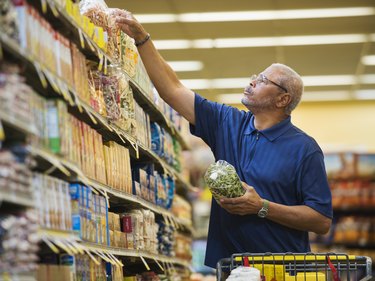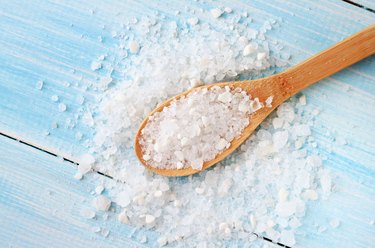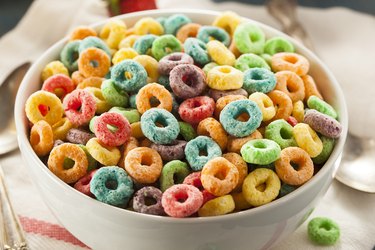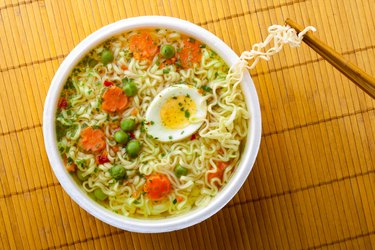
"Shop the perimeter and avoid the middle aisles" is a mantra health experts have preached for years to convince us to quit buying processed foods. But the narrative around processed foods has evolved.
Today, dietitians say many of the middle-aisle picks aren't all that bad. Rather, it's the additives in some (but not all) packaged picks that are cause for concern.
Food additives, such as artificial and natural flavors, preservatives and salt, are used during the manufacturing process to boost foods' palatability, texture and shelf-life. While everything on a food's ingredient list is deemed "generally recognized as safe" (aka GRAS) by the FDA, many common ingredients — from artificial sweeteners to MSG — are often vilified because third-party research links them to myriad health issues.
Rather than shunning the interior aisles of the grocery altogether and missing out on foods that are nutritious, convenient and economical, read on for a full breakdown of the various ingredients in packaged foods and which ones are actually worth avoiding.
There's More to Sweeteners Than Sugar

That sugar craving isn't all in your head: Humans are hardwired to love sweets. (Seriously! Sugar activates the reward system in the brain, according to a June 2011 study in the Journal of Opioid Management.)
While eating fruit daily is a good thing (and enjoying a piece of cake or a doughnut every once in a while is OK, too), indulging in too much sugar can cause weight gain and other health issues — which causes some of us to turn to sugar substitutes.
Beyond the stevia you started baking with, there are many other things you can use in place of sugar — think: molasses and erythritol. While the options seem endless, you'll want to be picky about which sweetener you choose.
Check which types of natural sweeteners, artificial sweeteners and sugar alcohols are actually good for you.
What's the Deal With Preservatives?

What do microwaveable dinners and jarred mayo have in common? They both have expiration dates that are in the distant future — and you can chalk that up to their preservatives.
Preservatives are food additives that help maintain the taste, texture, nutrition and appearance of food, Natalie Allen, RD, an instructor of biomedical sciences at Missouri State University, tells LIVESTRONG.com.
There are two main types: synthetic preservatives and natural preservatives. While many people associate the former with health issues, it might be reassuring to learn that these common additives are allowed in foods only at 1/100 of the amount that might be considered harmful.
We've sifted through the latest research to determine if the 10 most common food preservatives are safe to eat.
Salt vs. Sodium

Contrary to popular belief, sodium is not synonymous with salt.
Quick chemistry lesson: "Salt is a mineral that is made up of sodium and chloride," says Isabel Smith, RD, CDN. It's the sodium in salt that's linked to high blood pressure and heart disease.
But your body needs some sodium to function properly. The American Heart Association recommends limiting your daily intake to no more than 2,300 milligrams a day, with an ideal daily limit of 1,500 milligrams.
Find out which sodium limit makes sense for you and how to calculate how much is in your salt.
Natural and Artificial Flavors Aren't That Different

If you pay attention to the nutrition facts labels on packaged foods, you've probably seen the term "natural flavors" quite a bit — after all, it's the fourth most common ingredient listed on labels (following salt, water and sugar), according to the Environmental Working Group. But, as with many other additives, these flavorings still spark some confusion.
Here's where it gets murky: Artificial flavors are not so different from natural ones. Despite their name, most natural flavors are still produced in a lab, explains Riley Thornton, RDN, a nutritionist and wellness specialist at the University of Alabama at Birmingham.
Ultimately, anything categorized as a flavor or flavoring (regardless of whether it's natural or artificial) has been classified as safe to eat — at least in the very small amounts present in our food.
Compare natural and artificial flavors and see which types have come under fire.
Should You Really Avoid Food Dyes?

Ice cream covered with rainbow sprinkles and fruity cereal that turns your milk pink are some of life's simple pleasures, but behind the colorful appeal lies a darker side, some warn.
For years, consumer health advocates have argued that food dyes are linked to behavior problems and hyperactivity in children, although there's little evidence to support these claims. Artificial food dyes have also been associated with rare instances of triggering allergies.
And that's not all: "One of the drawbacks of artificial food dyes are the foods themselves they are used in," says Annessa Chumbley, RD, a registered dietitian and nutrition expert based in Indianapolis. "Often, they are high in sugar, have very little fiber and may have other overly processed ingredients in them."
Discover the difference between artificial and natural food dyes and which ones to avoid.
The Verdict on MSG

Monosodium glutamate, aka MSG, has been criticized for increasing appetite and causing uncomfortable side effects such as nausea and heart palpitations. But the salty flavor enhancer is GRAS by the FDA — and researchers haven't been able to find a definitive link between these symptoms and the food additive.
MSG is made out of sodium and glutamate (an amino acid) and might also be listed as "autolyzed yeast," "hydrolyzed yeast" and "yeast extract" on packaged snacks, bouillon cubes and frozen dinners.
Get to the bottom of the MSG controversy and find a list of foods that usually contain the flavor enhancer.